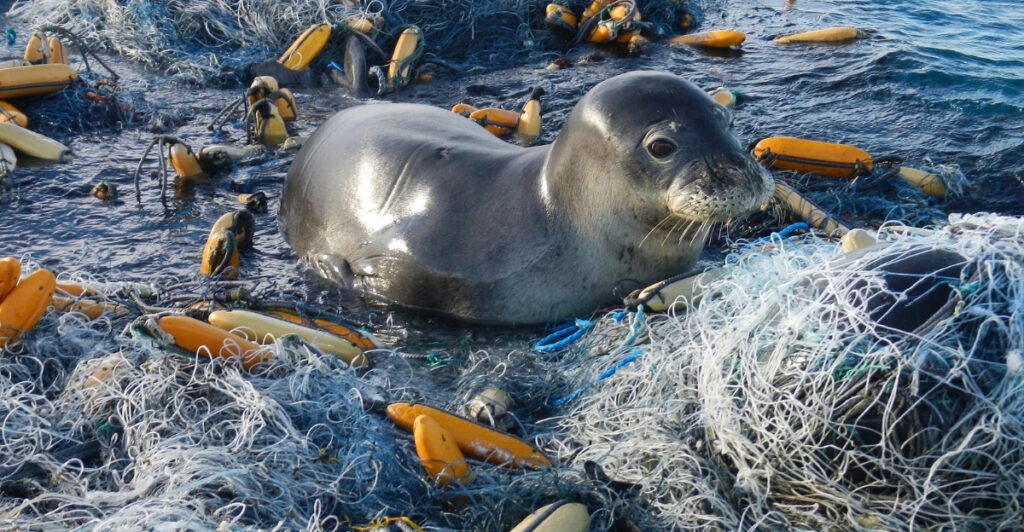
Hawaiian monk seals, one of the rarest seal species in the world, are no stranger to challenges. With only about 1,400 individuals left in the wild, they already face threats from climate change, human activity, and natural predators. But in recent years, researchers have been grappling with a strange and troubling issue: these seals are getting eels stuck in their noses.
A Strange and Growing Problem
Hawaiian monk seals are well-known for their ability to forage on the ocean floor, diving to depths of up to 500 feet to find food like fish, octopuses, and, of course, eels. However, a peculiar trend has recently emerged: Juvenile seals are frequently emerging from the water with eels lodged in their nostrils.
This oddity was first observed just a few years ago, but the instances have only increased since then. Charles Littnan, a conservation biologist with NOAA Fisheries, remarked that he had never encountered such an issue in his nearly four decades of studying monk seals until recently. “We have no idea why it’s happening,” he added.

How Do the Eels Get There?
To understand how eels might end up in the seals’ nasal cavities, it’s important to consider the seal’s hunting methods. Monk seals are not known for their speed in the water but instead rely on their excellent diving skills—up to 500 feet down—to root around in sand and coral, flipping over rocks in search of prey. Eels, coincidentally, tend to hide in crevices or burrow into the ocean floor. This leads to the theory thatseals might disturb an eel hiding in the rocks while rummaging around for food. The eel, perhaps sensing danger, may lash out in a desperate attempt to escape and, in doing so, could wedge itself into the seal’s nostril.
Another possibility is that the seal catches the eel and then brings it to the surface to eat. While trying to swallow it, the eel might go the wrong way, traveling up into the nasal passage rather than the stomach. In most cases, then, the eel becomes stuck when it tries to escape or when the seal regurgitates it. A less likely, but still possible, explanation is that the eel tries to seek refuge in the seal’s nose to avoid being consumed.
Why Does This Even Matter?
While the situation may seem comical, it actually poses severe risks to the seals. Hawaiian monk seals rely on their ability to close their nostrils tightly when they dive underwater, preventing water from flooding their nasal passages and lungs. If an eel blocks one of their nostrils, it could interfere with this vital function. The seal could end up inhaling water, leading to complications like pneumonia or other respiratory issues.

Another danger is the potential for infection. If the eel dies and begins to decompose while lodged in the seal’s nose, bacteria could spread, putting the seal’s health at further risk. Fortunately, researchers have been able to remove the eels from the seals’ noses quickly, but the fact that this issue is becoming more frequent has raised concerns about the longer-term impact on the population.
A Concern for Conservationists
Though critically endangered, the population of Hawaiian monk seals has been steadily increasing thanks to conservation efforts by organizations like NOAA Fisheries. Yet despite these efforts, the seals continue to face various threats, including habitat loss, shark predation, and entanglement in fishing gear. While odd, the rise in eel-nose incidents could indicate that the seals’ environment is changing in ways researchers don’t fully understand.

Littnan notes that the problem seems to have emerged only recently, and researchers are unsure whether it’s a temporary phenomenon or part of a larger trend. “We don’t know if this is just a statistical quirk or if it’s something that’s going to continue,” he said. The increasing frequency of these incidents raises concerns that the behavior could be linked to changes in the seals’ food sources and the marine environment’s overall health.
Ongoing Efforts and What We Can Learn
Luckily, experts’ awareness of the problem has led to successful intervention in every case of an eel getting stuck in a seal’s nose. The seals are temporarily captured, and the eels—sometimes over two feet long—are removed swiftly and carefully. While effective, these interventions can carry risks for the seals, as the process can be stressful and may cause injury. Given the small population of Hawaiian monk seals, any added stress could have serious consequences. Researchers work quickly and gently to minimize harm and allow the seals to return to their natural behaviors as soon as possible.

While the strange eel-in-nose phenomenon may seem minor compared to other threats like habitat destruction or climate change, it emphasizes the complexity of the marine ecosystem. Each new discovery, whether it’s an unusual ailment or shifting seal behavior, provides valuable insights into the challenges these seals face. To ensure the species’ survival, conservation efforts must continue to evolve alongside the ever-changing nature of these creatures and their environment.
Resources:
- NOAA Fisheries: Hawaiian Monk Seal
- Live Science: Young Seals Keep Getting Eels Stuck Up Their Noses, and Nobody Knows Why
- Atlas Obscura: The Mysterious Phenomenon of Seals With Eels in Their Noses
Stay connected with us for more stories like this! Follow us to get the latest updates or hit the Follow button at the top of this article, and let us know what you think by leaving your feedback below. We’d love to hear from you!







